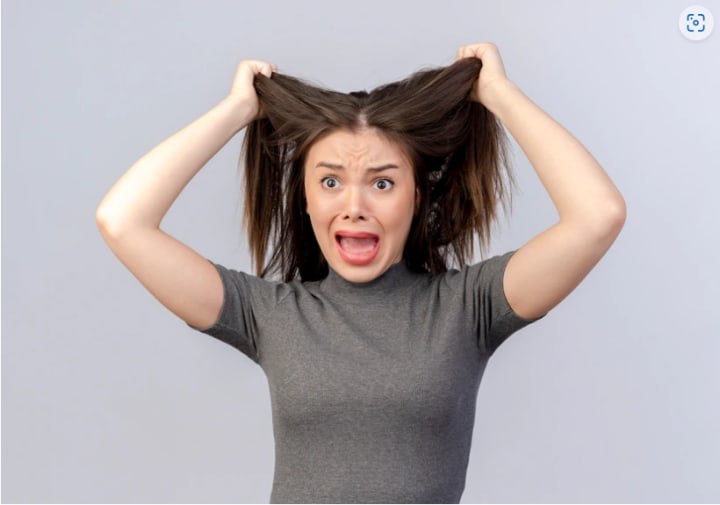How I Recovered from Creatine-Induced Hair Loss with Red Light Therapy
Gracie Smith

I have always been proud of my hair. It was thick, shiny, and long, and I loved to style it in different ways. I used to get compliments on my hair all the time, and it made me feel confident and beautiful.
But everything changed when I started taking creatine.

I was a fitness enthusiast, and I wanted to improve my performance, muscle growth, and strength. I heard that creatine was a popular supplement that could help me achieve my goals. Creatine is naturally produced by the body and can also be found in foods like meat, fish, and eggs. Creatine helps to provide energy to the muscles by increasing the production of a molecule called adenosine triphosphate (ATP), which is the main source of fuel for cellular activities.
I did some research online and found that creatine was generally safe and effective, with minimal side effects. I decided to give it a try and bought a jar of creatine powder from a reputable brand. I followed the instructions on the label and started loading with 25 grams of creatine per day for 7 days, followed by 5 grams per day for maintenance.
At first, I didn’t notice any difference in my hair. I was more focused on my workouts and my results. I felt stronger, faster, and more energetic. I could lift heavier weights, run longer distances, and recover faster. I was happy with my progress and continued taking creatine for several weeks.

But then, I started noticing more hair on my pillow, on my brush, and in the shower. At first, I thought it was normal shedding, but then it became more noticeable and alarming. My hair was thinning, especially on the crown and temples. My scalp was more visible, and my hairline was receding. I was horrified and panicked.
I searched online for the possible causes of my hair loss, and I came across a study that linked creatine to hair loss. The study involved 20 healthy male rugby players who took creatine for 21 days. The researchers found that after taking creatine, the participants had a significant increase in their levels of dihydrotestosterone (DHT), which is a hormone that can cause hair loss by shrinking hair follicles.
DHT is a metabolite of testosterone that is produced by an enzyme called 5-alpha reductase. DHT has a stronger affinity for androgen receptors than testosterone, which means that it can bind more easily and activate them. Androgen receptors are found in various tissues in the body, including the skin, prostate, and hair follicles. When DHT binds to the androgen receptors in the hair follicles, it can trigger a process called miniaturization, which causes the follicles to shrink and produce thinner and shorter hairs. Over time, this can lead to hair loss, especially in men who have a genetic predisposition to androgenetic alopecia (AGA), also known as male pattern baldness.
I realized that creatine might be the culprit behind my hair loss. I was shocked and angry. How could something that was supposed to help me improve my fitness ruin my hair? Why didn’t anyone warn me about this potential side effect? Why didn’t I do more research before taking creatine?
I immediately stopped taking creatine and hoped that my hair would grow back. But it didn’t. My hair continued to fall out and thin out. I tried various products and treatments to stop or reverse my hair loss, such as shampoos, conditioners, supplements, oils, medications, etc., but nothing worked. I felt hopeless and depressed.
I hated looking at myself in the mirror. I hated going out in public. I hated seeing people stare at my scalp or pity me. I hated feeling insecure and unattractive. I hated losing my identity and self-esteem.
I was desperate for a solution.
That’s when I discovered red light therapy and red light therapy pros and cons.
Red light therapy is a non-invasive and painless treatment that uses low-level laser light to stimulate cellular activity and promote healing. Red light therapy has been proven by multiple studies to be effective for hair growth by increasing blood flow to the scalp, enhancing follicle function, and extending the anagen (growth) phase of the hair cycle .
I learned about best red light therapy for hair growth from a friend who had a similar problem with hair loss. She told me that she had tried everything, but nothing worked until she tried red light therapy. She showed me her before and after pictures, and I was amazed by the difference. Her hair was thicker, fuller, and healthier than ever. She looked younger and happier.
She recommended me to try a red light therapy cap. A red light therapy cap is a device that fits over your head and emits red light to your scalp. It is convenient, easy to use, and safe. You can use it at home for about 20 minutes per day for several weeks or months to see noticeable results.
I was skeptical at first, but I decided to give it a try. I ordered a red light therapy cap online from a reputable company that offered a money-back guarantee. I received it in a few days and started using it right away.

At first, I didn’t notice any difference in my hair. I was impatient and frustrated. But then, after a few weeks, I started noticing some changes. My hair was shedding less and growing faster. My scalp was less visible, and my hairline was improving. I was excited and hopeful.
I continued using the red light therapy cap for several months, and I was amazed by the results. My hair was restored to its former glory. It was thick, shiny, and long again. I could style it in different ways again. I received compliments on my hair again. I felt confident and beautiful again.
I was overjoyed and grateful.
Red light therapy changed my life.
Red light therapy has many advantages over other treatments for hair loss, such as:
- It is natural and does not involve any chemicals or drugs that may have side effects or interactions.
- It is painless and does not cause any discomfort or damage to the skin or hair.
- It is affordable and cost-effective compared to other treatments that may require frequent visits or prescriptions.
- It is suitable for both men and women with different types of hair loss.
However, red light therapy also has some disadvantages, such as:
- It may not work for everyone or for every type of hair loss. Some people may respond better than others depending on their genetics, age, health status, etc.
- It may take some time to see noticeable results. Some people may see improvement within weeks while others may need months or even years.
- It may require consistent and regular use to maintain the results. If you stop using the red light therapy cap , your hair growth may slow down or revert back to its previous state.
Therefore, you should consult your doctor before trying red light therapy cap and follow the instructions carefully.
This is my story of how I lost my hair due to creatine and how I found a solution with red light therapy. I hope it can inspire you or help you if you are going through a similar situation.
Have you ever experienced hair loss due to creatine or any other supplement? Have you ever tried red light therapy or any other treatment for hair growth? What was your experience like? Please share your story with me in the comments below. I would love to hear from you!
About the Creator
Healthy Fun
After years of exploration, I believe that health is the secret to happiness.






Comments
There are no comments for this story
Be the first to respond and start the conversation.